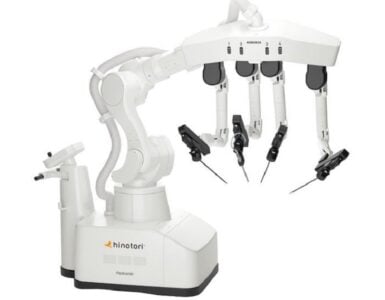
Minimally invasive robotic surgery (MIRS) merges human knowledge and intelligence with the precision of a machine, resulting in tremendous benefits for patients. Still, there are limitations to this evolving technique, such as the loss of haptic feedback, which is eliminated when the surgeon no longer manipulates the instrument directly. Haptics is a conjunction of both kinesthetic (form and shape of muscles, tissues and joints) as well as tactile (cutaneous texture and fine detail) perception, and is a combination of many physical variables such as force, distributed pressure, temperature and vibration.
So how can the sense of haptic feedback be restored in MIRS and make the interaction between surgeon and robot become more intuitive and seamless? The answer lies in sophisticated micro-miniature force sensors that are installed at the surgical end-effector, creating a haptic feedback control system for the endoscope that helps:
- Influence the surgeon’s ability to generate a safe laparoscopic grasp while pulling and manipulating tissues of variable stiffness.
- Improve the surgeon’s ability to sense tissue consistency, arterial pulse detection, and force control during surgical procedures.
FUTEK specializes in designing and manufacturing miniature haptic feedback sensors for robotic surgery. The development of these units requires achieving a set of complex but crucial goals :
- overcoming the technical obstacles of designing a sensor for intra-abdominal force measurement (miniaturization, biocompatibility, autoclavability and high reusability)
- maintaining the minimally required specification of a high-grade force measurement solution (nonlinearity, hysteresis, repeatability, cross-talk, bandwidth and noise-free resolution).
Designing solutions for intra-abdominal direct sensing
When considering the inherent complexity of measuring haptics, engineers and neuroscientists must face important issues that require consideration prior to the sensor design and manufacturing stages, such as the location of the sensing element, which significantly influences the measurement consistency. In MIRS applications, where very delicate instrument-tissue interaction forces need to give precise feedback to the surgeon, measurement accuracy is sine qua non, which makes laparoscopic surgery with force sensing the ideal option.
However, this approach demands higher reusability. Commercially available MIRS systems that are modular in design allow the laparoscopic instrument to be reutilized approximately 12 to 20 times. This means that viable sensing solution components have to withstand additional autoclavable cycles as well as survive a high PH washing. Coping with these special design requirements invariably increases the unitary cost per sensor. However, extended lifespan and number of cycles significantly brings down the cost per cycle.

Developing hermetically sealed sensors
Achieving sensor hermeticity in intra- abdominal direct force measurement requires a departure from conventional approaches to sealing electronic components. Conformal coatings are not sufficiently airtight and adding a welded header interface to the miniaturized sensor would make its footprint too large. FUTEK has created a novel and robust approach to achieve hermeticity by developing a monolithic sensor using custom-formulated, Ct matched, chemically neutral, high-temperature-fused isolator technology to feed electrical conductors through the walls of the hermetically sealed active sensing element. This fused isolator technology has shown reliability in the hundreds to thousands of autoclave cycles.

Designing for a flawless performance
In addition to meeting physical requirements like miniaturization, biocompatibility, autoclavability and high reusability, it is equally imperative that the force measurement device performs with extreme accuracy and reliability. Some of the challenges to consider are:
Minimizing extraneous loads — In robotic surgery, the sensor must be designed to negate the extraneous or cross-talk loads, which include frictions between the end-effector instrument and trocar, reactionary forces from the abdominal wall and gravitational effect of mass along the instrument axis.
FUTEK’s haptic feedback sensors for robotic surgery feature extraneous loads (or crosstalk) compensation, which provides optimal resistance to off-axis loads to assure maximum operating life and minimize reading errors.
Optimizing calibration — A direct inline force sensor imposes restrictions on the final calibration as it can be affected by parallel load paths. FUTEK’s sensors include calibration fixtures that are optimized with SR buttons to direct load precisely through the sensor of the part, eliminating errors.
Compensating thermal effects — Exposure to the temperature variations inherent in the MIRS process can cause material expansion, gauge factor coefficient variation and other undesirable effects on the measurement result. For this reason, FUTEK’s solutions feature temperature compensation, which ensures accuracy and long-term stability even when the sensor is exposed to severe ambient temperature oscillations. The compensation measures are:
(a) the use of high-quality, custom and self-compensated strain gauges compatible with the thermal expansion coefficient of the sensing element material;
(b) use of half or full Wheatstone bridge circuit configuration installed in both load directions (tension and compression) to correct for temperature drift
(c) fully internally temperature compensation of zero balance and output range without the necessity of external conditioning circuitry.
Reducing solder joints — Multiple solder joints in a unit can cause reliability issues. FUTEK’s custom strain gauges have reduced solder connections (from 16 to less than six), which helps to significantly reduce temperature impacts and risk for failure.
Enabling high volume production — During the design phase, it is important to take manufacturability into account. Automated, high-volume processes could be significantly different from the benchtop or prototype equipment used for producing lower volumes. FUTEK’s engineering team designs with scalability in mind, meaning that we maintain focus on reducing failure points during the manufacturing process.
Endurance and longevity— In medical sensors, overload and fatigue testing must be performed in conjunction with the sterilization testing in an intercalated process. FUTEK’s haptic feedback sensors are able to survive hundreds of overload cycles while maintaining hermeticity, translating into a failure-free, high-reliability sensor with lower MTBF and more competitive total cost of ownership.
Creating the optimal product development environment
In order to successfully develop high-performing and highly manufacturable haptic feedback sensors, the sensor solution provider has to be equipped with a talented multidisciplinary engineering team, in-house manufacturing capabilities that are supported by fully developed quality processes, and high product/project management proficiency to handle the complex, resource-limited, and fast-paced new product development environment.
Multi-disciplinary engineering team
FUTEK’s engineering team identifies and translates customer needs into a cross-functional design as well as deploys novel approaches to old problems whose solutions are not easily found by a single, one-sided technical view. The design team includes both mechanical engineers who can navigate through the latest machine design technologies as well as electrical engineers that are capable of designing instrumentation solutions to meet strict signal conditioning requirements. This multi-disciplinary approach results in sensor solutions that meet the specifications in terms of nonlinearity, hysteresis, repeatability and cross-talk, as well as electronic instruments that deliver analog and digital output, high sampling rate and bandwidth, high noise-free resolution and low power consumption, all necessary for a reliable turnkey haptics measurement solution.
In-house manufacturing
Comprehensive internal manufacturing capabilities enable FUTEK
to control all aspects of the production process. This allows us to better meet demanding schedule and quality requirements as well as engineering sensors with a Design for Manufacturability (DFM) mentality. This strategic control of manufacturing boils down to methodically selecting the bill of material, defining the testing plans, complying with standards and protocols and ultimately strategizing the manufacturing phase based on economic constraints.
Building a culture of excellence
Quality is expensive, but lack of quality costs even more. In medical applications where failure is not an option and tolerances are tight, the project stakeholders cannot afford to have quality as a meager department of testers whose job is to find defects before the customer does. Instead, FUTEK fosters a rigorous and relentless commitment to a culture of excellence which permeates throughout all company processes, from design to shipping. The quality system is effectively implemented and maintained through ISO 13485 certification as well ISO 17025 accredited testing and calibration laboratories.
Surgical robotic companies who are pursuing a marketable product that incorporates haptic feedback will find that FUTEK is uniquely positioned to offer a measurement solution that meets all design requirements imposed by intra-abdominal force measurement in MIRS: miniaturization, biocompatibility, autoclavability, high reusability and measurement accuracy.









